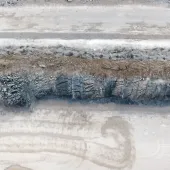Visibility from Earthmoving Machinery

First published in the May 2016 issue of Quarry Management
How is it Looking?
By Malcolm Kent, senior technical consultant, Construction Equipment Association
Anyone involved in the safety of earthmoving machinery will probably already know that there is a problem with the technical standard for what operators need to be able to see from their workstation. This goes back several years to when a German citizen submitted a petition on the matter to the European Parliament. His claim was that the standard that earthmoving machinery manufacturers were using in the design of machinery – ISO 5006 – did not provide a sufficient level of safety. After a long process of investigation and consultation the European Commission came to the conclusion that he was right, and in January 2015 published what is called a Decision. This Decision stated that the standard had been deemed inadequate and that the Commission’s approval of the standard was being withdrawn. What this means is that although the standard still exists, manufacturers can no longer rely on it as a way to claim that their machines are safe enough with regards to visibility.
What does the standard currently require? There are two areas where visibility is assessed under the 2006 edition of the standard: first, on a 12.0m circle around the machine at ground level, and secondly, on a 1.5m high post moved around a rectangle set 1.0m out from the footprint of the machine. The detailed requirements vary depending on machine type and size but the principles are the same for all. It should be noted that there is no requirement to be able to see anything at all between 1.0m and 12.0m from the machine, although in practice the operator would be able to see a great deal in this range. The main complaint in the original petition was that significant blind spots behind the machine were allowed under the standard and this led to the risk of accidents.
What does ‘safe enough’ mean? This depends on a risk assessment covering the type of machine, the size of machine, how it moves and how fast, how its work equipment (if any) moves and how it is used. That is quite a lot to consider but this is what each manufacturer needs to do in the absence of any technical standard that they can hang their hats on. It is not just manufacturers who are uneasy in the absence of a suitable technical standard: safety authorities across Europe are trying to produce guidance for manufacturers and are supporting the development of a new standard. The Health and Safety Executive has issued its own guidance document (available for download from the HSE website) which covers some key considerations without going into a lot of detail.
Where are we going with the new standard? That is really hard to say. There are lots of fingers in the pie, from countries a long way away from Europe (remember that the standard is an ISO, ie an international one) who do not really see the need to plaster machines with mirrors, cameras, radar etc, to countries at the heart of Europe with a culture that demands the highest level of technical risk reduction on products. Because of this, there is a real tension over how much to change the ISO standard and it is not clear yet whether the project will succeed in publishing anything. Even if it does, it is by no means certain that the European Commission would deem it as being satisfactory. If it did not, it would mean that the effort had been in vain as the block on the use of the standard would remain in place.
The other possibility is that new requirements on visibility could be written into a European standard, meaning that the influence of the ‘rest of the world’ would disappear. On the face of it, this would seem more likely to succeed in producing a standard acceptable to the European Commission but the focus of work still seems to be missing the target as far as some people see it.
All this means that we are unlikely to have in our hands for several years (yes, years) a standard for machine visibility which will provide the level of clarity that manufacturers, customers and safety authorities all crave.
What are we all to do in the meantime? Many manufacturers will be looking at the HSE guidance, which, among other things, tells them to review and update their risk assessments, to review what is available in terms of visibility aids, and to keep themselves informed on how work on revising the standard is progressing. That last point is virtually impossible as the work is going in fits and starts, in two directions at once. The guidance also recommends including ‘visibility maps’ in the machine instructions showing the blind spots around the machine. Given how often instruction manuals are used it is questionable whether this will reduce accidents. As far as customers are concerned, some are asking manufacturers what they are doing about visibility and some are taking things into their own hands, installing after-market camera systems or other aids. Although there is nothing wrong with this, machine owners need to be aware that, along with the system supplier, they are taking over a significant chunk of responsibility for risk assessment.
At the current point in time there is no clear vision on visibility. Manufacturers have to stand on their own two feet in risk assessment and the provision of visibility aids, and that situation is likely to continue for quite some time.







